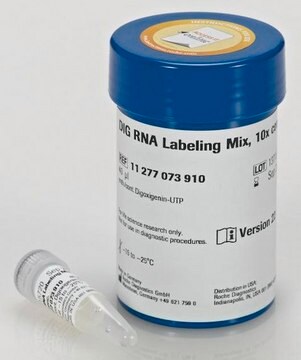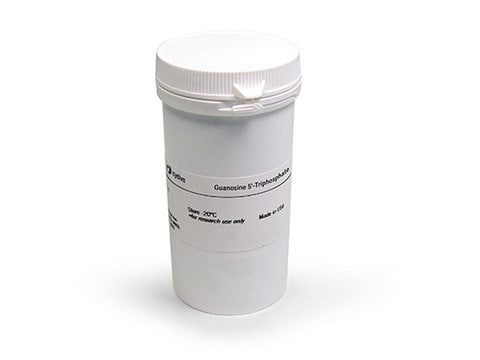10999644001
Roche
SP6/T7 Transcription Kit
sufficient for 2 x 20 assays (stadard transcription), kit of 1 (12 components), suitable for DNA sequencing, suitable for hybridization
Synonym(s):
rna labeling, radioactive, transcription kit sp6/t7
Sign Into View Organizational & Contract Pricing
All Photos(1)
About This Item
UNSPSC Code:
41105803
Recommended Products
usage
sufficient for 2 x 20 assays (stadard transcription)
Quality Level
packaging
kit of 1 (12 components)
manufacturer/tradename
Roche
technique(s)
DNA sequencing: suitable
hybridization: suitable
storage temp.
−20°C
General description
Sample Material
DNA inserted into the transcription vectors pSPT18 or pSPT19.The template DNA must be linearized with a suitable restriction enzyme before the transcription reaction to obtain transcripts of a defined length. Using intact plasmid DNA as template for transcription will result in heterogeneous transcripts of multiple plasmid lengths.
DNA inserted into the transcription vectors pSPT18 or pSPT19.The template DNA must be linearized with a suitable restriction enzyme before the transcription reaction to obtain transcripts of a defined length. Using intact plasmid DNA as template for transcription will result in heterogeneous transcripts of multiple plasmid lengths.
Specificity
Heat inactivation: Stop the reaction by adding 2 μl 0.2 M EDTA (pH 8.0) and/or heating to 65 °C for 10 minutes.
Application
Convenient kit for radioactive or nonradioactive labeling of RNA by the in vitro transcription with SP6 and T7 polymerase. The kit can also be used for "cold" transcription assays. By the in vitro transcription method single-stranded RNA probes of known length are produced, which can be used in a variety of hybridization techniques.
For in vitro transcription of DNA sequences cloned downstream of the SP6 or T7 promoter. Homogeneously labeled RNA can be synthesized with high efficiency (60 - 70% incorporation) using either radioactively (e.g.,32P, 3H, 35S) labeled or nonradioactively (e.g., digoxigenin or biotin) labeled ribonucleotides. Labeled transcripts lend themselves to all DNA and RNA hybridization techniques and are also used for genomic sequencing and S1 nuclease studies. Large amounts of highly pure RNA can be synthesized using the SP6/T7 system. These transcripts are used for studies on RNA-processing systems. Synthesized RNA can be translated in vitro, or in vivo after injection into oocytes. The transcription of defined mRNA can be inhibited by the introduction of "antisense"-RNA. The efficiency of in vivo translation of synthesized mRNA can be increased significantly by the introduction of a cap structure.
For in vitro transcription of DNA sequences cloned downstream of the SP6 or T7 promoter. Homogeneously labeled RNA can be synthesized with high efficiency (60 - 70% incorporation) using either radioactively (e.g.,32P, 3H, 35S) labeled or nonradioactively (e.g., digoxigenin or biotin) labeled ribonucleotides. Labeled transcripts lend themselves to all DNA and RNA hybridization techniques and are also used for genomic sequencing and S1 nuclease studies. Large amounts of highly pure RNA can be synthesized using the SP6/T7 system. These transcripts are used for studies on RNA-processing systems. Synthesized RNA can be translated in vitro, or in vivo after injection into oocytes. The transcription of defined mRNA can be inhibited by the introduction of "antisense"-RNA. The efficiency of in vivo translation of synthesized mRNA can be increased significantly by the introduction of a cap structure.
Packaging
1 kit containing 12 components.
Principle
DNA is inserted into the polylinker site of the transcription vectors pSPT18 or pSPT19; these two vectors differ only in the orientation of their polylinker regions. The promoters for SP6 and T7 RNA polymerases are located on either side of the polylinker. SP6 and T7 RNA polymerases specifically transcribe DNA sequences downstream of the SP6 or T7 promoters, respectively. Cloned inserts within the polylinker region are transcribed from either promoter. The first DNA strand may be transcribed with SP6 RNA polymerase and the opposite strand using T7 RNA polymerase. It is also possible to transcribe the first and opposite strands by inserting the same DNA into both pSPT18 and pSPT19 in opposite orientations and transcribing with only one of the RNA polymerases. SP6 and T7 RNA polymerase use the cloned DNA as template and synthesize complementary RNA in the presence of Mg2+ and ribonucleoside triphosphates. Spermidine stimulates enzyme activity. Specifically labeled transcripts are obtained when using radioactively (e.g., 32P, 3H, 35S) or nonradioactively (e.g., digoxigenin or biotin) labeled ribonucleotide triphosphates.
Preparation Note
Working solution: Standard Labeling Assay
ATP, GTP, UTP mixture
Prepare the ATP, GTP, UTP mixture by making a 1:1:1 mixture of solution 4, solution 6, and solution 7.
Transcription Assay with digoxigenin-11-UTP
ATP, GTP, CTP mixture 1
Mix 1:1:1 of ATP (vial 4), CTP (vial 5), and GTP (vial 6).
UTP/DIG-11-UTP mixture
Mix 1:1 digoxigenin-11-UTP (6 mM) with UTP (vial 7) and add as one part to mixture 1.
"Cold" Transcription
ATP, GTP, CTP, UTP mixture
Prepare this mix by combining solutions in vials 4, 5, 6 and 7 at a ratio of 1111.
ATP, GTP, UTP mixture
Prepare the ATP, GTP, UTP mixture by making a 1:1:1 mixture of solution 4, solution 6, and solution 7.
Transcription Assay with digoxigenin-11-UTP
ATP, GTP, CTP mixture 1
Mix 1:1:1 of ATP (vial 4), CTP (vial 5), and GTP (vial 6).
UTP/DIG-11-UTP mixture
Mix 1:1 digoxigenin-11-UTP (6 mM) with UTP (vial 7) and add as one part to mixture 1.
"Cold" Transcription
ATP, GTP, CTP, UTP mixture
Prepare this mix by combining solutions in vials 4, 5, 6 and 7 at a ratio of 1111.
Other Notes
For life science research only. Not for use in diagnostic procedures.
Kit Components Only
Product No.
Description
- pSPT18 DNA 0.25 mg/ml
- pSPT19 DNA 0.25 mg/ml
- Control DNA, (pSPT18- and pSPT19-neo-DNA, cleaved with Eco RI) 0.5 mg/ml
- ATP, in Tris buffer 10 mM
- CTP, in Tris buffer 10 mM
- GTP, in Tris buffer 10 mM
- UTP, in Tris buffer 10 mM
- Transcription Buffer 10x concentrated
- DNase I, RNase free, in buffer with 50% glycerol
- RNase Inhibitor, in buffer with 50% glycerol
- SP6 RNA Polymerase, in buffer with 50% glycerol
- T7 RNA Polymerase, in buffer with 50% glycerol
See All (12)
Signal Word
Warning
Hazard Statements
Precautionary Statements
Hazard Classifications
Eye Irrit. 2 - Skin Sens. 1
Storage Class Code
12 - Non Combustible Liquids
WGK
WGK 2
Flash Point(F)
does not flash
Flash Point(C)
does not flash
Certificates of Analysis (COA)
Search for Certificates of Analysis (COA) by entering the products Lot/Batch Number. Lot and Batch Numbers can be found on a product’s label following the words ‘Lot’ or ‘Batch’.
Already Own This Product?
Find documentation for the products that you have recently purchased in the Document Library.
Customers Also Viewed
Le Tran Phuc Khoa et al.
PloS one, 11(7), e0159246-e0159246 (2016-07-15)
Fibroblast growth factor 5 (Fgf5) has been widely used as a marker for the epiblast in the postimplantation embryo and epiblast stem cells (mEpiSCs) in the mouse, making it valuable for study of differentiation of various tissues and epiblast cells
Ying-Juan Zheng et al.
FASEB journal : official publication of the Federation of American Societies for Experimental Biology, 33(11), 12915-12928 (2019-09-27)
Nasopharyngeal carcinoma (NPC) is a malignant epithelial cancer of the head and neck with high prevalence in southern China, which is accompanied by notable invasiveness and metastasis. Long noncoding RNAs (lncRNAs) participate in the progression of various cancers including NPC.
Madeline Bucher et al.
Scientific reports, 6, 19867-19867 (2016-01-26)
Symbiosis between photosynthetic algae and heterotrophic organisms is widespread. One prominent example of high ecological relevance is the endosymbiosis between dinoflagellate algae of the genus Symbiodinium and reef-building corals, which typically acquire symbionts anew each generation during larval stages. The
Maxime Gasnier et al.
Nature protocols, 8(12), 2538-2547 (2013-11-23)
RNA in situ hybridization (ISH) has been widely used in cell and developmental biology research to study gene expression. Classical ISH protocols use colorimetric staining approaches, such as the assay with nitro blue tetrazolium/5-bromo-4-chloro-3-indolyl-phosphate (NBT/BCIP), which do not allow the
Yanqiu Hu et al.
BMC developmental biology, 11, 58-58 (2011-10-01)
TG-interacting factors (TGIFs) belong to a family of TALE-homeodomain proteins including TGIF1, TGIF2 and TGIFLX/Y in human. Both TGIF1 and TGIF2 act as transcription factors repressing TGF-β signalling. Human TGIFLX and its orthologue, Tex1 in the mouse, are X-linked genes
Our team of scientists has experience in all areas of research including Life Science, Material Science, Chemical Synthesis, Chromatography, Analytical and many others.
Contact Technical Service






